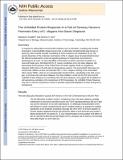The Unfolded Protein Response in a Pair of Sensory Neurons Promotes Entry of C. elegans into Dauer Diapause
Author(s)
Kulalert, Warakorn; Kim, Dennis H.
DownloadKim_The unfolded.pdf (307.6Kb)
PUBLISHER_CC
Publisher with Creative Commons License
Creative Commons Attribution
Terms of use
Metadata
Show full item recordAbstract
In response to unfavorable environmental conditions such as starvation, crowding, and elevated temperature, Caenorhabditis elegans larvae enter an alternative developmental stage known as dauer [ 1], which is characterized by adaptive changes in stress resistance and metabolism [ 2 ; 3]. The genetic dissection of the molecular mechanisms of the C. elegans dauer developmental decision has defined evolutionarily conserved signaling pathways of organismal neuroendocrine physiology [ 2; 3 ; 4]. Here, we have identified a mechanism by which a dominant mutation in a neuronal insulin gene, daf-28(sa191) [ 5; 6 ; 7], causes constitutive entry into dauer diapause. We demonstrate that expression of the mutant DAF-28 insulin peptide results in endoplasmic reticulum (ER) stress in the ASI pair of chemosensory neurons. The neuronal ER stress does not compromise cellular survival but activates PEK-1, the C. elegans ortholog of the mammalian eIF2α kinase PERK, which in turn phosphorylates Ser49 of eIF2α, specifically in the ASI neuron pair, to promote entry into dauer diapause. Our data establish a novel role for ER stress and the unfolded protein response (UPR) in promoting entry into dauer diapause and suggest that, in addition to cell-autonomous activities in the maintenance of ER homeostasis, the UPR may act in a non-cell-autonomous manner to promote organismal adaptation to stress during larval development.
Date issued
2013-12Department
Massachusetts Institute of Technology. Department of BiologyJournal
Current Biology
Publisher
Elsevier
Citation
Kulalert, Warakorn, and Dennis H. Kim. “The Unfolded Protein Response in a Pair of Sensory Neurons Promotes Entry of C.?elegans into Dauer Diapause.” Current Biology 23.24 (2013): 2540–2545.
Version: Author's final manuscript
ISSN
0960-9822
1879-0445